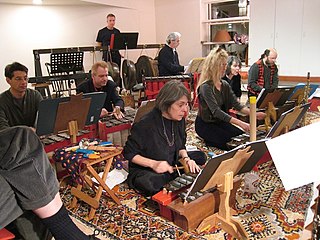Related Research Articles

Gamelan is the traditional ensemble music of the Javanese, Sundanese, and Balinese peoples of Indonesia, made up predominantly of percussive instruments. The most common instruments used are metallophones played by mallets and a set of hand-played drums called kendhang/Kendang, which register the beat. The kemanak and gangsa are commonly used gamelan instruments in Bali. Other instruments include xylophones, bamboo flutes, a bowed instrument called a rebab, a zither-like instrument siter and vocalists named sindhen (Female) or gerong (Male).

Lou Silver Harrison was an American composer, music critic, music theorist, painter, and creator of unique musical instruments. Harrison initially wrote in a dissonant, ultramodernist style similar to his former teacher and contemporary, Henry Cowell, but later moved toward incorporating elements of non-Western cultures into his work. Notable examples include a number of pieces written for Javanese style gamelan instruments, inspired after studying with noted gamelan musician Kanjeng Notoprojo in Indonesia. Harrison would create his own musical ensembles and instruments with his partner, William Colvig, who are now both considered founders of the American gamelan movement and world music; along with composers Harry Partch and Claude Vivier, and ethnomusicologist Colin McPhee.

Pelog is one of the essential tuning systems used in gamelan instruments that has heptatonic scale. The other, older, scale commonly used is called slendro. Pelog has seven notes, but many gamelan ensembles only have keys for five of the pitches. Even in ensembles that have all seven notes, many pieces only use a subset of five notes, sometimes the additional 4th tone is also used in a piece like western accidentals.

SlendroPlay (help·info) is one of the essential tuning systems used in gamelan instruments that has pentatonic scale. Based on Javanese mythology, the Slendro Gamelan tuning system is older than the pélog tuning system.

Gamelan surakarta A typical large, double gamelan in contemporary solo (Surakarta) will include, in the sléndro set, one saron panerus, two saron barung, one or two saron demung, one gendér panerus, one gender barung, one slenthem, one bonang panerus and one bonang barung, one gambang kayu, one siter or celempung, one rebab, one suling, one pair of kethuk and kempyang, one set of three to five kenong, one set of three to five kempul, one to three gong suwukan, and one gong ageng.

American gamelan could refer to both instruments and music; the term has been used to refer to gamelan-style instruments built by Americans, as well as to music written by American composers to be played on gamelan instruments. American gamelan music usually has some relationship to the gamelan traditions of Indonesia, as found primarily on the islands of Java and Bali in a variety of styles. Many American compositions can be played on Indonesian or American-made instruments. Indonesian gamelan can be made of a variety of materials, including bronze, iron, or bamboo. American gamelan builders used all sorts of materials including aluminum, tin cans, car hubcaps, steel, antique milk-strainers, etc. American gamelan may also describe the original music of American ensembles working with traditional instruments.

Dennis Murphy was a composer, musician, instrument maker, artist, and playwright.

The Music of Java embraces a wide variety of styles, both traditional and contemporary, reflecting the diversity of the island and its lengthy history. Apart from traditional forms that maintain connections to musical styles many centuries old, there are also many unique styles and conventions which combine elements from many other regional influences, including those of neighbouring Asian cultures and European colonial forms.

Gamelan Son of Lion (GSOL) is a new-music American gamelan ensemble based in New York City. The group was founded in 1976 by Barbara Benary, Philip Corner, and Daniel Goode. It is a composers' collective as well as repertory ensemble. Current composers in the group in addition to the co-founders are: David Demnitz, Laura Liben, Jody Kruskal, Lisa Karrer, Marnen Laibow-Koser, Jody Diamond, and David Simons.

A gendèr is a type of metallophone used in Balinese and Javanese gamelan music. It consists of 10 to 14 tuned metal bars suspended over a tuned resonator of bamboo or metal, which are tapped with a mallet made of wooden disks (Bali) or a padded wooden disk (Java). Each key is a note of a different pitch, often extending a little more than two octaves. There are five notes per octave, so in the seven-note pélog scale, some pitches are left out according to the pathet. Most gamelans include three gendèr, one for sléndro, one for pelog pathet nem and lima, and one for pelog pathet barang.

A kempul is a type of hanging gong used in Indonesian gamelan. The kempul is a set of pitched, hanging, knobbed gongs, often made of bronze, wood, and cords. Ranging from 19 cm to 25,4 cm in diameter, the kempul gong has a flat surface with a protruding knob at the center and is played by hitting the knob with the "soft end of a mallet." "The wooden mallet used has a ball shape head with heavy padding on a short wooden handle. The number of kempul gongs present in a gamelan ensemble varies but, "although there can be two to ten kempul on one separate rack, it is common to have five kempul hanging on the same rack as the Gong ageng and gong siyem".

Jody Diamond is an American composer, performer, writer, publisher, editor, and educator. She specializes in traditional and new music for Indonesian gamelan and is active internationally as a scholar, performer, and publisher.

The bonang is an Indonesian musical instrument used in the Javanese gamelan. It is a collection of small gongs placed horizontally onto strings in a wooden frame (rancak), either one or two rows wide. All of the kettles have a central boss, but around it the lower-pitched ones have a flattened head, while the higher ones have an arched one. Each is tuned to a specific pitch in the appropriate scale; thus there are different bonang for pelog and slendro. They are typically hit with padded sticks (tabuh). This is similar to the other cradled gongs in the gamelan, the kethuk, kempyang, and kenong. Bonang may be made of forged bronze, welded and cold-hammered iron, or a combination of metals. In addition to the gong-shaped form of kettles, economical bonang made of hammered iron or brass plates with raised bosses are often found in village gamelan, in Suriname-style gamelan, and in some American gamelan. In central Javanese gamelan there are three types of bonang used:
Pathet is an organizing concept in central Javanese gamelan music in Indonesia. It is a system of tonal hierarchies in which some notes are emphasized more than others. The word means '"to damp, or to restrain from" in Javanese. Pathet is "a limitation on the player's choice of variation, so that while in one pathet a certain note may be prominent, in another it must be avoided, or used only for special effect. Awareness of such limitations, and exploration of variation within them reflects a basic philosophical aim of gamelan music, and indeed all art in central Java, namely, the restraint and refinement of one's own behaviour." Javanese often give poetic explanations of pathet, such as "Pathet is the couch or bed of a melody." In essence, a pathet indicates which notes are stressed in the melody, especially at the end of phrases (seleh), as well as determines which elaborations are appropriate. In many cases, however, pieces are seen as in a mixture of pathets, and the reality is often more complicated than the generalizations indicated here, and depend on the particular composition and style.
The American Gamelan Institute (AGI) is an organization devoted to promoting and documenting all forms of gamelan, the performing arts of Indonesia, and their international counterparts.

Gamelan, although Indonesia is its origin place, is found outside of that country. There are forms of gamelan that have developed outside Indonesia, such as American gamelan and Malay Gamelan in Malaysia.
(Joseph) Vincent McDermott was a classically trained American composer and ethnomusicologist. His works show particular influence from the musics of South and Southeast Asia, particularly the gamelan music of Java. He was among the second generation of American composers to create and promote new compositions for gamelan.

Gamelan Munggang are considered among the most ancient gamelans of the kraton (courts) of central Java. The ensemble of instruments consists of gong ageng, kempul, kendang and horizontal gong chimes tuned to three pitches. Very low in absolute pitch, each ensemble consists of two types: pelog and slendro. There is a repertory of several repetitive pieces, the best known permutation being high-middle-high-low. It is theorized that pelog was derived from the three note munggang scale. The origin of the munggang ensembles themselves are described in Javanese myths, however the first one may have been imported to Indonesia in the first century CE, with the first ensemble constructed by the Javanese made in the 4th century.
References
- ↑ "Profile". Gamelan Pacifica. Retrieved March 25, 2022.
- ↑ Benary, Barbara; Jody Diamond; Richard North; Marc Hoffman. "Gamelan Groups in the USA". American Gamelan Institute. Archived from the original on September 4, 2009. Retrieved September 13, 2009.
- ↑ Diamond, Jody; Benary, Barbara (2001). ""Indonesian music," In The United States and Canada.". In Koskoff, Ellen (ed.). The Garland Encyclopedia Of World Music and Dance. Vol. 3. pp. 1011–1033.
- ↑ (2010). "Liner Notes", Scenes from Cavafy: Music for Gamelan album, p.5-6.